


OH-58D Kiowa Warrior
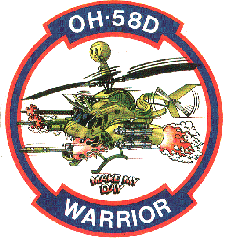 The OH-58D Kiowa Warrior is a two-place single engine armed reconnaissance helicopter. The OH-58D's highly accurate navigation system permits precise target location that can be handed-off to other engagement systems. The OH-58D has an infrared thermal imaging capability and can display night vision goggle flight reference symbology. It's laser designator/laser rangefinder can provide autonomous designation for laser-guided precision weapons. Air-to-Air Stinger (ATAS) issiles provide the Kiowa Warrior with protection against threat aircraft.
The OH-58D Kiowa Warrior is a two-place single engine armed reconnaissance helicopter. The OH-58D's highly accurate navigation system permits precise target location that can be handed-off to other engagement systems. The OH-58D has an infrared thermal imaging capability and can display night vision goggle flight reference symbology. It's laser designator/laser rangefinder can provide autonomous designation for laser-guided precision weapons. Air-to-Air Stinger (ATAS) issiles provide the Kiowa Warrior with protection against threat aircraft.
The primary mission of the Kiowa Warrior is armed reconnaissance in air cavalry troops and light attack companies. In addition, the Kiowa Warrior may be called upon to participate in the following missions or tasks:
- Joint Air Attack (JAAT) operations
- Limited attack operations
- Artillery target designation.
The Kiowa Warrior is an armed version of the earlier OH-58D Kiowa Advanced Helicopter Improvement Program (AHIP) aircraft, which itself was a highly modified version of the OH-58A/C Kiowa. A hostile gunboat presence at night in the Persian Gulf in 1987 created the need for a small armed
scout helicopter for interdiction. Close team work between the U.S. Armed Forces and Bell Helicopter Textron, Inc. developed the OH-58D Kiowa Warrior in less than 100 days, to counter this threat.
The Kiowa Warrior procurement plan is to acquire, through modification or retrofit of existing OH-58A
and D aircraft, approximately 401 Kiowa Warriors. There are two concurrent programs which produce
Kiowa Warriors: a program which modifies OH-58A aircraft, and a retrofit program that will eventually
re-configure all 185 OH-58D Army Helicopter Improvement Program models. The Department of the
Army has specified an acquisition objective of 507 Kiowa Warriors even though the current
procurement authorization is for only 401 of them.
The first Kiowa Warrior was delivered to the Army in May 1991. It is replacing selected AH-1 Cobra
attack helicopters (those that function as scouts in air cavalry troops and light attack companies), and
OH-58A and C Kiowas in air cavalry troops. Initially a Full Material Release decision was scheduled
for Q4FY94. However, the aircraft has been able to attain only a "conditional" material release from the
Army Materiel Command due to the autorotation issue described below and other safety concerns. The
Kiowa Warrior was placed on the OSD oversight list in 1990 for DT, OT, and as a LFT candidate.
There is no B-LRIP report or acquisition decision required for this system, however a LFT&E report
will be submitted to Congress.
The Mast Mounted Sight (MMS) is one of the key elements of the Kiowa Warrior. Its unique day/night capabilities allow the crew to scan the battlefield with the ability to acquire, identify, and derive the coordinate locations of potential targets.
The US Navy selected the Kiowa Warrior Mast Mounted Sight for
use on their ships. They were so pleased with it's performance that they entered into a program to update the technology in the existing platform. Their current Mast Mounted Sight II sight is smaller, lighter in
weight, and half the cost of the US Army MMS. In addition, the optics have been upgraded through the application of technology insertion. The dollar cost avoidance in acquisition, operations and support cost, and spare components to support this system on the Kiowa Warrior is potentially significant.
The AIM-1 MLR (and DLR), a class IIIb infrared (IR) laser, provides a beam of light invisible to the naked eye. Its beam is said to be effective for aiming at ranges up to 3km. It is designed to operate in conjunction with standard night vision devices (its beam's impact
point visible). The AIM-1 laser is boresighted to a point 2.8 inches vertically above the .50 Cal machine gun barrel bore center line of sight at a distance of 500 inches. This provides the proper offset for firing at a range of 1000 meters.
The principal difference between the Kiowa Warrior and its immediate OH-58D predecessor is a universal weapons pylon on both sides of the aircraft capable of accepting combinations of the semi-active laser Hellfire missile, the Air-to-Air Stinger (ATAS) missile, 2.75" Folding Fin Aerial Rocket (FFAR) pods, and a 0.50 caliber machine gun. In addition to these weapons, the Kiowa Warrior upgrade includes changes designed to provide improvements in air-to-air and air-to-ground communications, mission planning and management, available power, survivability, night flying, and reductions in crew workload through the use of on-board automation and cockpit integration.
Since the last OA conducted in FY94, the Army determined that modifications in mission and equipment over time have created a deficiency in the Kiowa Warrior autorotation capability. In general
terms, the cumulative addition of new equipment caused the weight of the aircraft to increase dramatically, meaning that in the event of an engine failure or other similar occurrence, the aircraft lost some of its original autorotative capability, causing the aircraft to descend faster and experience an extended ground slide upon touchdown. As a result, the Army developed a two-phase Safety Enhancement Program (SEP) to reduce the safety risk to Kiowa Warrior aviators. The SEP consists of both training and material changes.
An improved version of the T-703 (R-3) engine will be
installed which provides higher reliability and double the current overhaul interval, greater hot day power,
and a Full Authority Digital Electronic Control (FADEC). The FADEC provides automatic rotor speed
control, inflight restart, and performance recording, as well as more precise fuel metering capabilities.
Additionally, an integrated body and head restraint system, a cockpit air bag system, and energy
absorbing seats will be installed to enhance survivability in any crash situation.
Beginning in March 1997, a number of improvements were introduced
into new production OH-58Ds resulting from Task Force XXI exercises that took place at Fort Irwin, CA in March 1997, to demonstrate the Army's concept of the "digital battlefield". These improvements include an improved Allison 250-C30R/3 650 shp engine equipped with an upgraded hot section to improve high-altitude/hot-day performance. The C30R/3 will be fitted with a full authority digital electronic control system that will replace the hydromechanical fuel control unit. The improved
production Kiowa Warrior will have an integrated cockpit control and display system, master control processor with digital map and video crosslink, along with an improved data modem, secure radio
communications, and a GPS embedded in the inertial navigation system. Additional improvements include an infrared jammer, infrared suppressor, radar warning receivers, and a laser warning detector to improve aircraft survivability.
The robust sensor capabilities of the KW in its mission as an armed reconnaissance aircraft, would be greatly enhanced by more effective communications within today�s digitized battlefield. By using the highly integrated avionics already on the aircraft, this
capability can be added with only minor hardware and software changes.
Video Image Crosslink (VIXL) provides the KW with the capability to send and receive still frame images over one of the FM radios. The VIXL consists of a circuit card installed in the IMCPU. In 1996 the KW Product Manager�s Office (PMO) developed four VIXL ground stations, which consist of an Aviation Mission Planning Station (AMPS) with a
Tactical Communication Interface Modules (TCIM) and a SINCGARS radio. The ground stations will be used to transfer VIXL images on the ground.
Improved Mast Mounted Sight System Processor (IMSP) will replace the current configuration MMS System Processor (MSP). The product improved aircraft will include a new high-speed digital signal processor that will provide improved tracking capabilities by split-screen in both TV and Thermal Imaging Sight (TIS) modes, low contrast target tracking, simultaneous multi-target tracking of up to six targets, moving target indicator, aided target recognition, and automatic reaquiring of targets lost due to obstruction. The operator video display will reflect real time TV zoom and still frame capabilities. The IMSP enhancements consist of the use of high-speed Gallium Arsenide based digital signal processor integrated circuits in the MMS signal processor. The Circuit Card Assembly count in the processor will be reduced from 30 to 16. This reduction and use of state-of-the-art component technology enhances reliability, maintainability, and supportability. The IMSP will provide for enhanced growth and will not require substantial aircraft hardware changes. An update to the aircraft software, however, is required to execute the enhanced functions of the upgraded processor. This provides for future insertion of neural net automatic target recognition, identification of friend or foe, passive ranging, and real-time image enhancements. Form and fit of the existing MMS system processor is maintained, and is backwards compatible with the MMS System Processor (MSP). As of July 1997, all aircraft delivered from the Bell Helicopter production lots will have the
IMSP installed. All retrofit aircraft will be equipped MSPs. As the MSPs are removed through attrition, they are replaced with IMSPs.
The addition of weapons, improved cockpit integration, and better navigational capability have resulted in an aircraft that is much more capable than its predecessor. Furthermore, the potential enhancements to mission planning and management provided by the aviation mission planning system (AMPS) and data transfer system (DTS) were very apparent during the DSUFTP. All of these improvements were achieved without any noticeable impact on readiness, as indicated by the aircraft's operational availability.
Specifications
|
| Crew | 2 pilots
|
| Height | 12 feet 10.6 inches
|
| Length | 41 feet 2.4 inches
|
| Rotor diameter | 35 feet
|
| Maximum gross weight | 4,500 pounds (unarmed);
5,500 pounds (armed)
|
| Maximum airspeed | 125 KIAS
|
| Cruise airspeed | 80 KIAS
|
| Endurance | 2 hours
|
| Cargo hook capacity | 2,000 pounds
|
| Litter capacity | 4 (externally) |
| Troop-carrying capacity | 6 (externally). |
| Avionics |
Data transfer system ground station, data transfer module, data
transfer receptacle in the aircraft.
Video tape recorder records up to 2 hours of copilot's MFD.
ANVIS display symbology system provides basic flight information.
|
| Mast-mounted sight |
Thermal imaging sensor.
Television sensor.
Laser range finder/designator.
Optical boresight system.
|
| Weapons |
.50-caliber heavy machine gun. 70-millimeter folding fin aerial rocket. Air-to-air Stinger missile. Hellfire modular missile system.
|
| Communication equipment |
Two VHF-FM AN/ARC-186 or AN/ARC-201 SINCGARS.
One UHF AN/ARC-164 Have Quick.
One VHF-AM AN/ARC-186.
Two TSEC/KY-58.
HF capable (radio not installed).
TSEC/KY-75 (device not installed).
Retransmission capabilities.
FM homing (AN/ARC-186 only).
Airborne target handover system (digital communications).
|
| Navigation equipment |
Attitude and heading reference system (Litton LR-80 Inertial).
AN/ASN-137 doppler.
AN/ASN-43 directional gyro.
|
| Aircraft survivability equipment |
AN/APX-100 IFF.
AN/ALQ-144 IR jammer.
AN/APR-39A radar warning receiver.
AN/APR-44(V)3 radar warning receiver. AN/AVR-2 laser detecting set.
|
| Costs |
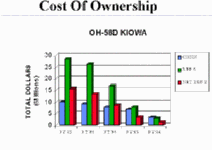
|
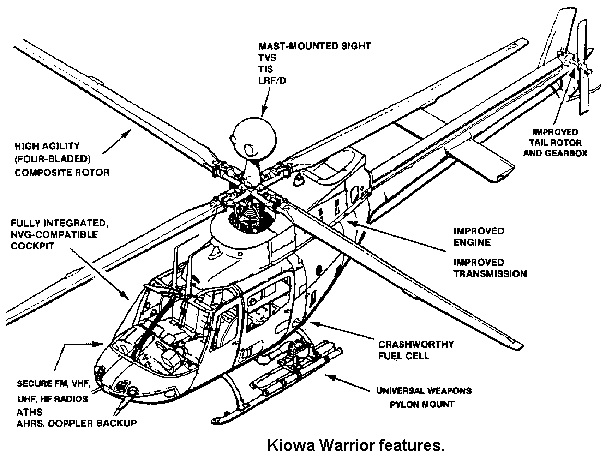
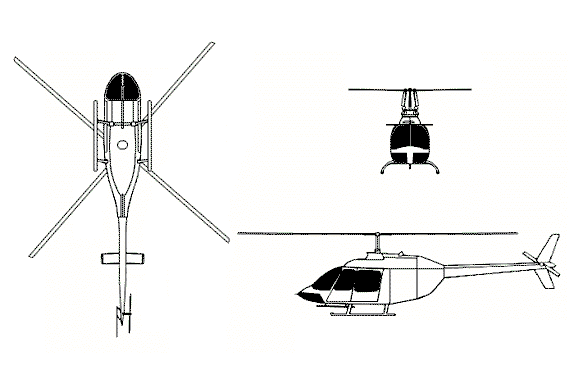
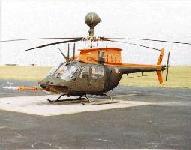
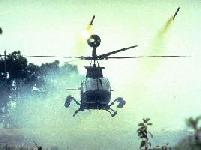
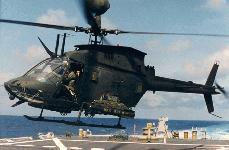
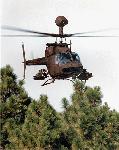
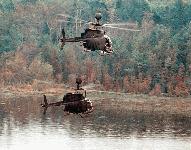
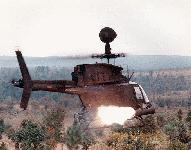
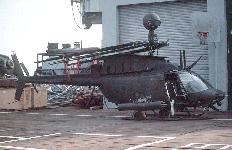
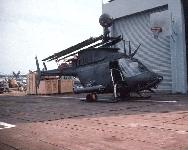
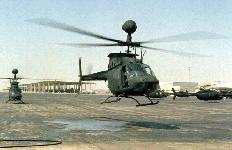
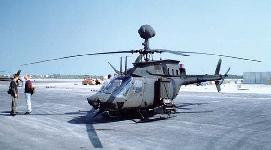

Sources and Resources
http://www.fas.org/man/dod-101/sys/ac/oh-58.htm
Maintained by Robert Sherman
Originally created by John Pike
Updated Monday, May 29, 2000 8:06:45 AM
 The OH-58D Kiowa Warrior is a two-place single engine armed reconnaissance helicopter. The OH-58D's highly accurate navigation system permits precise target location that can be handed-off to other engagement systems. The OH-58D has an infrared thermal imaging capability and can display night vision goggle flight reference symbology. It's laser designator/laser rangefinder can provide autonomous designation for laser-guided precision weapons. Air-to-Air Stinger (ATAS) issiles provide the Kiowa Warrior with protection against threat aircraft.
The OH-58D Kiowa Warrior is a two-place single engine armed reconnaissance helicopter. The OH-58D's highly accurate navigation system permits precise target location that can be handed-off to other engagement systems. The OH-58D has an infrared thermal imaging capability and can display night vision goggle flight reference symbology. It's laser designator/laser rangefinder can provide autonomous designation for laser-guided precision weapons. Air-to-Air Stinger (ATAS) issiles provide the Kiowa Warrior with protection against threat aircraft.
















